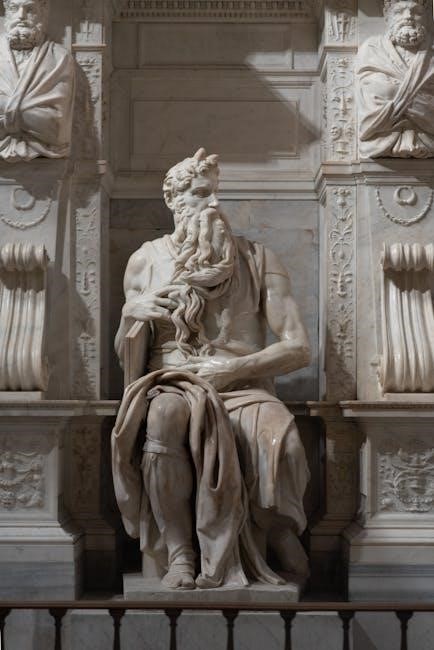The Assumption of Moses is an ancient text revealing Moses’ final prophecies and the figure of Taxo the Levite‚ offering insights into Jewish eschatology‚ available as a PDF for scholarly study.
1.1 Overview of the Text
The Assumption of Moses narrates Moses’ final moments and prophecies to Joshua‚ predicting severe Roman persecution and the rise of Taxo the Levite. The text‚ available as a PDF‚ explores themes of faith‚ eschatology‚ and moral guidance‚ offering insights into Jewish religious thought and its historical context‚ making it a valuable resource for scholarly and theological study.
1.2 Historical Significance
The Assumption of Moses holds profound historical significance as a rare‚ ancient text offering insights into early Jewish eschatology and religious thought. Its narratives about Moses’ prophecies and Taxo the Levite provide a window into the theological and cultural landscape of the time. Despite its fragmentary state‚ the text remains a crucial resource for understanding ancient Jewish traditions and their influence on later religious movements.
Composition and Structure of the Book
The Assumption of Moses is a fragmented text‚ originally in Hebrew‚ later translated into Greek and Latin. Its structure and composition pose challenges for scholars‚ with only a Latin manuscript surviving‚ analyzed in critical editions like Johannes Tromp’s work‚ aiding in understanding its complex textual history and theological themes.
2.1 The Problem of Scholarly Analysis
The Assumption of Moses presents significant challenges for scholars due to its fragmented state and uncertain origins. The original Hebrew and Greek versions are lost‚ with only a Latin manuscript surviving. This has led to debates over its composition and meaning. Scholars like Johannes Tromp have produced critical editions to address these issues‚ but the text’s complex history and incomplete nature continue to complicate analysis and interpretation.
2.2 Original Language and Translations
The Assumption of Moses is believed to have been written in Hebrew and later translated into Greek‚ with the only surviving manuscript being a Latin version from the sixth century. This translation has been crucial for understanding the text‚ though scholars debate its accuracy. Robert Henry Charles and Johannes Tromp have produced notable translations and editions‚ aiding in its study and interpretation despite the loss of the original versions.

Historical Context and Prophecies
The Assumption of Moses is set in a historical context of transition‚ detailing Moses’ final prophecies to Joshua. It foretells Roman persecution and the rise of Taxo‚ a pivotal eschatological figure.
3.1 Moses’ Final Prophecies to Joshua
Moses’ final prophecies to Joshua in the Assumption of Moses detail the transition of leadership and future events. The text describes Moses imparting divine knowledge‚ foresaw the Israelites’ struggles‚ and foretold their eventual redemption. It also includes visions of a Levite named Taxo‚ who plays a key role in eschatological events‚ emphasizing faith and resilience amidst persecution.
3.2 Predictions of Roman Persecution
The Assumption of Moses prophesies a devastating Roman persecution‚ describing the destruction of Jewish leaders and the concealment of their bodies. It foretells a period of suffering and oppression‚ emphasizing the need for faith and endurance. The text vividly portrays Rome’s brutality‚ aligning with historical accounts of Jewish-Roman conflicts. These predictions highlight the text’s historical relevance and its role in shaping Jewish eschatological expectations‚ preserved in the Latin manuscript.
The Figure of Taxo the Levite
Taxo the Levite is a central figure in the Assumption of Moses‚ embodying obedience and martyrdom‚ and holds significant eschatological importance in Jewish narratives.
4.1 Role in the Assumption of Moses
Taxo the Levite plays a pivotal role in the Assumption of Moses‚ depicted as a righteous figure who‚ alongside his sons‚ chooses martyrdom rather than defy divine law. His actions exemplify unwavering faith and obedience‚ serving as a moral beacon during a time of persecution. This narrative underscores the importance of steadfast commitment to religious principles‚ even in the face of severe adversity.
4.2 Significance in Eschatological Narratives
Taxo’s story in the Assumption of Moses holds profound eschatological significance‚ symbolizing hope and divine deliverance. His martyrdom and the subsequent prophecy of redemption align with broader Jewish apocalyptic themes‚ emphasizing faith in a messianic future. This narrative reinforces the belief in ultimate justice and restoration‚ resonating deeply within eschatological frameworks of ancient Jewish literature.

The Latin Manuscript and Its Importance
The Latin manuscript of the Assumption of Moses‚ dating to the sixth century‚ is a crucial text for understanding the original work‚ aiding biblical scholarship and studies.
5.1 The Sixth-Century Manuscript
The sixth-century Latin manuscript of the Assumption of Moses is the primary surviving source of the text. It provides critical insights into the original work‚ which was likely written in Hebrew and translated into Greek before being rendered into Latin. This manuscript is essential for scholars‚ as it preserves key theological themes and historical narratives‚ offering a window into Jewish eschatology and the figure of Moses’ prophetic legacy.
5.2 Contribution to Biblical Studies
The Assumption of Moses significantly contributes to biblical studies by offering unique eschatological perspectives and historical context. Its analysis sheds light on Jewish theology and early Christian influences. The text’s exploration of themes like divine judgment and redemption enriches scholarly understanding of ancient religious thought‚ making it a valuable resource for researchers examining the evolution of biblical narratives and their cultural impact.
Scholarly Contributions and Editions
Johannes Tromp’s critical edition and commentary on the Assumption of Moses provide invaluable insights‚ while Robert Henry Charles’ translations enhance accessibility for modern scholars and readers alike.
6.1 Johannes Tromp’s Critical Edition
Johannes Tromp’s critical edition of the Assumption of Moses provides a meticulous analysis of the text‚ offering insights into its historical and theological significance. His commentary enriches understanding of the manuscript‚ aiding scholars in navigating its complexities. Tromp’s work is indispensable for studying the Assumption of Moses‚ making it a cornerstone of modern biblical scholarship and ensuring its accessibility to researchers worldwide.
6.2 Robert Henry Charles’ Translations
Robert Henry Charles’ translations of the Assumption of Moses have significantly contributed to its accessibility. His work meticulously renders the Latin manuscript into English‚ preserving the text’s original meaning. Charles’ translations are celebrated for their accuracy and clarity‚ making the Assumption of Moses available to a broader audience and fostering deeper engagement with its eschatological themes and historical context.

Availability and Download Options
The Assumption of Moses is accessible as a PDF‚ with Johannes Tromp’s critical edition and Robert Henry Charles’ translations available for free download online.
7.1 PDF Downloads and Free Access
The Assumption of Moses is widely available as a PDF‚ with free downloads accessible through various academic platforms and repositories. Johannes Tromp’s critical edition and Robert Henry Charles’ translations are among the most sought-after versions. These PDFs provide scholars and enthusiasts with a convenient way to explore the text‚ ensuring its teachings and historical significance remain accessible to a broad audience.
7.2 Platforms for Accessing the Text
The Assumption of Moses can be accessed through various online platforms‚ including academic databases‚ religious studies websites‚ and open-access libraries. Google Books and scholarly repositories offer free downloads of the text‚ while platforms like JSTOR and Academia.edu provide additional resources for deeper study. These platforms ensure that the text remains readily available for both researchers and casual readers interested in its historical and religious significance.
Theological and Moral Themes
The text emphasizes moral living‚ faith‚ and divine justice‚ offering guidance for contemporary readers seeking spiritual enrichment and ethical wisdom rooted in ancient traditions and prophecies.
8.1 Moral Living and Faith
The Assumption of Moses underscores the importance of moral living and unwavering faith‚ emphasizing God’s justice and mercy. It urges believers to remain faithful despite trials‚ highlighting the consequences of sin and the rewards of righteousness. The text serves as a moral guide‚ encouraging readers to embrace ethical conduct and trust in divine providence‚ offering timeless lessons for spiritual growth and character development in a challenging world.
8.2 Guidance for Contemporary Readers
The Assumption of Moses offers timeless guidance‚ encouraging readers to embrace resilience‚ faith‚ and moral integrity in the face of adversity. Its themes of divine justice and redemption resonate with modern audiences‚ providing a framework for navigating life’s challenges. The text inspires reflection on ethical living and trust in God’s plan‚ making it a valuable resource for spiritual growth and decision-making in today’s complex world.
The Assumption of Moses is a significant text offering insights into Jewish theology and eschatology. Its prophecies and moral themes remain relevant‚ making it a valuable resource for modern scholarship and spiritual reflection on divine justice and redemption.
9.1 Summary of Key Insights
The Assumption of Moses offers profound insights into Jewish eschatology‚ detailing Moses’ final prophecies to Joshua and predicting Roman persecution. It introduces Taxo‚ a Levite with a pivotal eschatological role. The text emphasizes divine justice‚ moral living‚ and faith‚ providing guidance for contemporary readers. Its historical context and theological themes remain significant‚ making it a valuable resource for understanding ancient Jewish thought and its enduring relevance in modern scholarship.

9.2 Relevance in Modern Scholarship
The Assumption of Moses remains a vital text in modern biblical studies‚ offering insights into early Jewish eschatology and theology. Its analysis by scholars like Johannes Tromp and Robert Henry Charles underscores its importance. The availability of critical editions and translated PDFs facilitates academic research‚ making it a cornerstone for understanding ancient religious thought and its enduring influence on contemporary theological discussions.
